Introduction to Scala Functional Programming
- 1. ķv╩²ą═źūźĒź░źķź▀ź¾ź░ 2014-05-11 at żµż½żÓ├ŃÅŖ╗ß Suguru Hamazaki Introduction to Scala Functional Programming ╚ļ?ķT
- 4. ź¬źųźĖź¦ź»ź╚ųĖŽ“ż╚ ķv╩²ą═ż╬╚┌║Ž Have the best of both worlds. Construct elegant class hierarchies for maximum code reuse and extensibility, implement their behavior using higher-order functions. Or anything in-between. Ī¬ from http://www.scala-lang.org/ Object-Oriented Meets Functional
- 5. But ĪŁ
- 6. źčźķź└źżźÓźĘźšź╚żŽļyżĘżż A paradigm shift is dif?cult
- 10. ╝ā╗éķv╩² Pure Function ? ķv╩²ż╬įuü²ĮY╣¹ż¼ę²╩²ż╬éÄż╬ż▀ż╦ żĶż├żŲøQż▐żĻĪó═¼żĖéÄż“ėļż©żļż╚ │Żż╦═¼żĖéÄż╬ĮY╣¹ż“ĘĄż╣ ? ķv╩²ż╬įuü²ż╦żĶż├żŲĪóėQ£y┐╔─▄ż╩ Ė▒ū„ė├ż¼░k╔·żĘż╩żż f x y
- 12. ? ēõ╩²ż╦į┘┤·╚ļż╣żļ ? źŪ®`ź┐ż╬śŗįņż“ŲŲē▓Ą─ż╦ēõĖ³ż╣żļ ? ź¬źųźĖź¦ź»ź╚ż╬źšźŻ®`źļź╔ż╦éÄż“ź╗ź├ź╚ż╣żļ ? └²═Ōż“═Čż▓żļĪóź©źķ®`Ģrż╦ĮK┴╦ż╣żļ ? ź│ź¾źĮ®`źļż╦│÷┴”ż╣żļĪóźµ®`źČ®`╚ļ┴”ż“šiżÓ ? źšźĪźżźļż“šiż▀Ģ°żŁż╣żļ ? ź╣ź»źĻ®`ź¾ż╦├Ķ╗Łż╣żļ Variable reassigning Destructive mutation Setting ?eld values Throwing exceptions or stopping at failure Console output or reading user input File I/O Displaying to screen
- 13. ╝ā╗éķv╩²źūźĒź░źķźÓż“Ģ°ż» Write programs using only pure functions ż╬ż▀żŪ
- 14. ż©ż├?
- 17. ź¬źųźĖź¦ź»ź╚ųĖŽ“Ą─ź│źżź¾ case class OoCoin(private var head: Boolean) { def flip() = { head = !head } def stay() = {} // do nothing def get = head } Object-Oriented Coin
- 18. ź¬źųźĖź¦ź»ź╚ųĖŽ“Ą─ź│źżź¾ case class OoCoin(private var head: Boolean) { def flip() = { head = !head } def stay() = {} // do nothing def get = head } var (variable) żŪą¹čįżĘ ż┐źšźŻ®`źļź╔ż╦į┘┤·╚ļ Object-Oriented Coin
- 19. val c = OoCoin(true) c.flip() c.stay() c.flip() println("Showing a head? " + c.get)
- 22. val a = 5 sumOfSquares(a + 1, a * 2) def square(i: Int) = i * i def sumOfSquares(i1: Int, i2: Int) = square(i1) + square(i2)
- 23. val a = 5 sumOfSquares(a + 1, a * 2) def square(i: Int) = i * i def sumOfSquares(i1: Int, i2: Int) = square(i1) + square(i2) ╝ā╗éż╩ķv╩²
- 24. val a = 5 sumOfSquares(a + 1, a * 2) def square(i: Int) = i * i def sumOfSquares(i1: Int, i2: Int) = square(i1) + square(i2) ╝ā╗éż╩ķv╩² į┘┤·╚ļżŪżŁż╩żż val
- 25. ų├ōQźŌźŪźļ sumOfSquares(a + 1, a * 2) sumOfSquares(5 + 1, 5 * 2) sumOfSquares(6, 10) square(6) + square(10) (6 * 6) + (10 * 10) 36 + 100 136 Substitution Model http://mitpress.mit.edu/sicp/full-text/book/book-Z-H-10.html
- 26. į┘żėĪóź│źżź¾ż╬└²ż“ęŖżŲż▀żļ OK, letĪ»s go back to the coin model
- 27. val c = OoCoin(true) c.flip() c.stay() c.flip() println("Showing a head? " + c.get)
- 28. val c = OoCoin(true) c.flip() c.stay() c.flip() println("Showing a head? " + c.get) mutable ż╩źŪ®`ź┐śŗįņż╚ ĘŪ╝ā╗éķv╩²
- 29. val c = OoCoin(true) c.flip() c.stay() c.flip() println("Showing a head? " + c.get) mutable ż╩źŪ®`ź┐śŗįņż╚ ĘŪ╝ā╗éķv╩² ▓╬šš═Ė▀^ąįżŽ?
- 30. ▓╗ēõż╩ź│źżź¾ż╚ ╝ā╗éķv╩²ż“╩╣ż” Use immutable coins and pure functions
- 31. case class Coin(head: Boolean) ! object Coin1 { def flip(c: Coin) = Coin(!c.head) def stay(c: Coin) = c }
- 32. case class Coin(head: Boolean) ! object Coin1 { def flip(c: Coin) = Coin(!c.head) def stay(c: Coin) = c } case class ż╬źšźŻ®` źļź╔żŽźŪźšź®źļź╚żŪ immutable
- 33. case class Coin(head: Boolean) ! object Coin1 { def flip(c: Coin) = Coin(!c.head) def stay(c: Coin) = c } case class ż╬źšźŻ®` źļź╔żŽźŪźšź®źļź╚żŪ immutable ╩▄ż▒╚Īż├ż┐CoinżŽēõĖ³ż╗ż║Īóą┬żĘżżCoinż“╔·│╔
- 34. val c0 = Coin(true) val c1 = flip(c0) val c2 = stay(c1) val c3 = flip(c2) println("Showing a head? " + c3.head)
- 35. val c0 = Coin(true) val c1 = flip(c0) val c2 = stay(c1) val c3 = flip(c2) println("Showing a head? " + c3.head)
- 36. ź│źżź¾ż╬ ▓┘ū„ ź»źķź╣żŪ▒Ē¼FżĘżŲż▀żļ ż“ Express an Ī«ActionĪ» of a coin with a class
- 37. case class CoinAction(action: Coin => Coin) extends (Coin => Coin) { def apply(c: Coin) = action(c) def +(next: CoinAction): CoinAction = CoinAction { c0 => val c1 = action(c0) next(c1) } }
- 38. case class CoinAction(action: Coin => Coin) extends (Coin => Coin) { def apply(c: Coin) = action(c) def +(next: CoinAction): CoinAction = CoinAction { c0 => val c1 = action(c0) next(c1) } } Coinż╬ū┤æBż“▀węŲżĄ ż╗żļķv╩²ż“źķź├źū
- 39. case class CoinAction(action: Coin => Coin) extends (Coin => Coin) { def apply(c: Coin) = action(c) def +(next: CoinAction): CoinAction = CoinAction { c0 => val c1 = action(c0) next(c1) } } Coinż╬ū┤æBż“▀węŲżĄ ż╗żļķv╩²ż“źķź├źū ūį╔ĒżŌķv╩²ż╚żĘżŲÆQż©żļ
- 40. case class CoinAction(action: Coin => Coin) extends (Coin => Coin) { def apply(c: Coin) = action(c) def +(next: CoinAction): CoinAction = CoinAction { c0 => val c1 = action(c0) next(c1) } } Coinż╬ū┤æBż“▀węŲżĄ ż╗żļķv╩²ż“źķź├źū ūį╔ĒżŌķv╩²ż╚żĘżŲÆQż©żļ ĪĖź│źżź¾ż“╩▄ż▒╚Īż├ż┐Ģrż╦Īóūį ╔Ēż╬ action ż“īgąążĘżŲż½żķĪó┤╬ ż╬▓┘ū„ż“īgąąż╣żļĪ╣ż╚żżż”ķv╩²
- 41. case class CoinAction(action: Coin => Coin) extends (Coin => Coin) { def apply(c: Coin) = action(c) def +(next: CoinAction): CoinAction = CoinAction { c0 => val c1 = action(c0) next(c1) } } Coinż╬ū┤æBż“▀węŲżĄ ż╗żļķv╩²ż“źķź├źū ūį╔ĒżŌķv╩²ż╚żĘżŲÆQż©żļ ķv╩²ż╚żĘżŲ║¶żė│÷żĄżņż┐ļHż╦Īó źķź├źūżĘż┐ķv╩²ż“īgąą ĪĖź│źżź¾ż“╩▄ż▒╚Īż├ż┐Ģrż╦Īóūį ╔Ēż╬ action ż“īgąążĘżŲż½żķĪó┤╬ ż╬▓┘ū„ż“īgąąż╣żļĪ╣ż╚żżż”ķv╩²
- 42. First class Functions ? ę²╩²ż╚żĘżŲČ╔ż╗żļ ? æ°żĻéÄż╚żĘżŲĘĄż╗żļ ? ēõ╩²ż╦┤·╚ļżŪżŁżļ
- 43. val flip = CoinAction(c => Coin(!c.head)) val stay = CoinAction(c => c) ?ip, stay ż“ CoinAction ż╬ źżź¾ź╣ź┐ź¾ź╣ż╚żĘżŲČ©┴x
- 44. val action = flip + stay + flip val c = action(Coin(true)) println("Showing a head? " + c.head) +() źßźĮź├ź╔żŪ▓┘ū„ż“ 1ż─ż╦ż▐ż╚żßżļ
- 45. val action = flip + stay + flip val c = action(Coin(true)) println("Showing a head? " + c.head) +() źßźĮź├ź╔żŪ▓┘ū„ż“ 1ż─ż╦ż▐ż╚żßżļ żŪżŌĪó═Šųąż╬ĮY╣¹żŌ ė¹żĘżżĢrżŽŻ┐
- 46. case class CoinAction[A](action: Coin => (Coin, A)) extends (Coin => (Coin, A)) { def apply(c: Coin) = action(c) def +[B](next: CoinAction[B]): CoinAction[B] = flatMap(_ => next) def map[B](f: A => B): CoinAction[B] = CoinAction { c0 => val (c1, a) = apply(c0) (c1, f(a)) } def flatMap[B](f: A => CoinAction[B]): CoinAction[B] = CoinAction { c0 => val (c1, a) = apply(c0) f(a)(c1) } }
- 47. case class CoinAction[A](action: Coin => (Coin, A)) extends (Coin => (Coin, A)) { def apply(c: Coin) = action(c) def +[B](next: CoinAction[B]): CoinAction[B] = flatMap(_ => next) def map[B](f: A => B): CoinAction[B] = CoinAction { c0 => val (c1, a) = apply(c0) (c1, f(a)) } def flatMap[B](f: A => CoinAction[B]): CoinAction[B] = CoinAction { c0 => val (c1, a) = apply(c0) f(a)(c1) } } Coinż╚ę╗Šwż╦╚╬ęŌż╬ą═ż╬ĮY╣¹ż“ĘĄż╣
- 48. case class CoinAction[A](action: Coin => (Coin, A)) extends (Coin => (Coin, A)) { def apply(c: Coin) = action(c) def +[B](next: CoinAction[B]): CoinAction[B] = flatMap(_ => next) def map[B](f: A => B): CoinAction[B] = CoinAction { c0 => val (c1, a) = apply(c0) (c1, f(a)) } def flatMap[B](f: A => CoinAction[B]): CoinAction[B] = CoinAction { c0 => val (c1, a) = apply(c0) f(a)(c1) } } Coinż╚ę╗Šwż╦╚╬ęŌż╬ą═ż╬ĮY╣¹ż“ĘĄż╣ ▀węŲżĘż┐ĮY╣¹ż“ ╚╬ęŌż╬ą═ż╦ēõōQż╣żļ
- 49. case class CoinAction[A](action: Coin => (Coin, A)) extends (Coin => (Coin, A)) { def apply(c: Coin) = action(c) def +[B](next: CoinAction[B]): CoinAction[B] = flatMap(_ => next) def map[B](f: A => B): CoinAction[B] = CoinAction { c0 => val (c1, a) = apply(c0) (c1, f(a)) } def flatMap[B](f: A => CoinAction[B]): CoinAction[B] = CoinAction { c0 => val (c1, a) = apply(c0) f(a)(c1) } } Coinż╚ę╗Šwż╦╚╬ęŌż╬ą═ż╬ĮY╣¹ż“ĘĄż╣ ▀węŲżĘż┐ĮY╣¹ż“ ╚╬ęŌż╬ą═ż╦ēõōQż╣żļ ┤╬ż╬▓┘ū„ż╚ĮMż▀║Žż’ż╗żļĪŻż┐ż└żĘĪó Ū░ż╬ĮY╣¹ż“į¬ż╦┤╬ż╬▓┘ū„ż“╔·│╔ż╣żļ ķv╩²ż╚żĘżŲ╩▄ż▒╚Īżļ
- 50. val flip = CoinAction { c => val head = !c.head (Coin(head), head) } val stay = CoinAction(c => (c, c.head))
- 51. val flip = CoinAction { c => val head = !c.head (Coin(head), head) } val stay = CoinAction(c => (c, c.head)) Coinż╚ę╗Šwż╦ Boolean ą═ż╬ĮY╣¹ż“ ĘĄż╣
- 52. val action = flip.flatMap { _ => stay.flatMap { _ => flip } } val (c, _) = action(Coin(true)) println("Showing a head? " + c.head)
- 53. val action = flip.flatMap { _ => stay.flatMap { _ => flip } } val (c, _) = action(Coin(true)) println("Showing a head? " + c.head) ?ip + stay + ?ip ż╚ ═¼śöż╬ź│®`ź╔
- 54. val action = flip.flatMap { _ => stay.flatMap { _ => flip } } val (c, _) = action(Coin(true)) println("Showing a head? " + c.head) ?ip + stay + ?ip ż╚ ═¼śöż╬ź│®`ź╔ ż┐ż└żĘĪóģgż╩żļ CoinActionżŪżŽż╩ż»ĪóCoinAction ż“ĘĄ ż╣ķv╩²ż“Č╔żĘżŲżżżļ
- 55. val action = flip.flatMap { b1 => stay.flatMap { _ => flip.map { b3 => (b1, b3) } } } val (_, (b1, b3)) = action(Coin(true)) println("1st occurrence is a head? " + b1) println("3rd occurrence is a head? " + b3)
- 56. val action = flip.flatMap { b1 => stay.flatMap { _ => flip.map { b3 => (b1, b3) } } } val (_, (b1, b3)) = action(Coin(true)) println("1st occurrence is a head? " + b1) println("3rd occurrence is a head? " + b3) ĮY╣¹ż¼ Tuple ż╦ż╩żļżĶż” map() żŪēõōQ
- 57. val action = flip.flatMap { b1 => stay.flatMap { _ => flip.map { b3 => (b1, b3) } } } val (_, (b1, b3)) = action(Coin(true)) println("1st occurrence is a head? " + b1) println("3rd occurrence is a head? " + b3) ĮY╣¹ż¼ Tuple ż╦ż╩żļżĶż” map() żŪēõōQ ?atMap() ż¼╩▄ż▒żļż╬żŽĪóĮ±ż╬▓┘ū„ż╬ĮY╣¹ż½żķĪó┤╬╗žęįĮĄż╬▓┘ū„ż“ū„żļķv╩²ĪŻ
- 58. val action = flip.flatMap { b1 => stay.flatMap { _ => flip.map { b3 => (b1, b3) } } } val (_, (b1, b3)) = action(Coin(true)) println("1st occurrence is a head? " + b1) println("3rd occurrence is a head? " + b3) ĮY╣¹ż¼ Tuple ż╦ż╩żļżĶż” map() żŪēõōQ ?atMap() ż¼╩▄ż▒żļż╬żŽĪóĮ±ż╬▓┘ū„ż╬ĮY╣¹ż½żķĪó┤╬╗žęįĮĄż╬▓┘ū„ż“ū„żļķv╩²ĪŻ ż╩ż╬żŪĪób1, b3 ż¼ź═ź╣ź╚ żĘż┐─┌▓┐źųźĒź├ź»żŪ└¹ė├ żŪżŁżļ
- 59. val action = for { b1 <- flip _ <- stay b3 <- flip } yield (b1, b3) val (_, (b1, b3)) = action(Coin(true)) println("1st occurrence is a head? " + b1) println("3rd occurrence is a head? " + b3) map(), ?atMap() ż¼żóżņżąĪófor-comprehension ż¼╩╣ż©żļ
- 60. val action = for { s1 <- flip.map(b1 => "1st occurrence is a head? " + b1) _ <- stay s3 <- flip.map(b3 => "3rd occurrence is a head? " + b3) } yield (s1 + "n" + s3) val (_, s) = action(Coin(true)) println(s)
- 61. val action = for { s1 <- flip.map(b1 => "1st occurrence is a head? " + b1) _ <- stay s3 <- flip.map(b3 => "3rd occurrence is a head? " + b3) } yield (s1 + "n" + s3) val (_, s) = action(Coin(true)) println(s) ż│ż╬ĢrĄŃżŪĪó CoinAction[Boolean] ż“ CoinAction[String] ż╦ēõōQżĘżŲ żĘż▐ż”
- 63. case class CoinAction[A](action: Coin => (Coin, A)) extends (Coin => (Coin, A)) { def apply(c: Coin) = action(c) def +[B](next: CoinAction[B]): CoinAction[B] = flatMap(_ => next) def map[B](f: A => B): CoinAction[B] = CoinAction { c0 => val (c1, a) = apply(c0) (c1, f(a)) } def flatMap[B](f: A => CoinAction[B]): CoinAction[B] = CoinAction { c0 => val (c1, a) = apply(c0) f(a)(c1) } }
- 64. case class CoinAction[A](action: Coin => (Coin, A)) extends (Coin => (Coin, A)) { def apply(c: Coin) = action(c) def +[B](next: CoinAction[B]): CoinAction[B] = flatMap(_ => next) def map[B](f: A => B): CoinAction[B] = CoinAction { c0 => val (c1, a) = apply(c0) (c1, f(a)) } def flatMap[B](f: A => CoinAction[B]): CoinAction[B] = CoinAction { c0 => val (c1, a) = apply(c0) f(a)(c1) } } Coin ż╬źßźĮź├ź╔ż“ż╔ż│ ż½żķżŌ║¶żė│÷żĘżŲż╩żż
- 65. case class State[S, +A](run: S => (S, A)) { def map[B](f: A => B): State[S, B] = State { s => val (s2, a) = run(s) (s2, f(a)) } def flatMap[B](f: A => State[S, B]): State[S, B] = State { s => val (s2, a) = run(s) f(a).run(s2) } } Coin ż“ą═źčźķźß®`ź┐®` S ż╚żĘżŲ│ķŽ¾╗» Functional Programming in Scala http://www.manning.com/bjarnason/ żĶżĻÆi╗éĪóę╗▓┐Ė─ēõ
- 66. type CoinAction[A] = State[Coin, A] val flip: CoinAction[Boolean] = State { c => val head = !c.head (Coin(head), head) } val stay: CoinAction[Boolean] = State(c => (c, c.head)) CoinAction ż“ type alias ż╚żĘżŲČ©┴x
- 68. Wait ĪŁ
- 70. Scalaz Scalaz provides purely functional data structures to complement those from the Scala standard library. Ī¬ from http://typelevel.org/projects/scalaz/
- 71. import scalaz.State type CoinAction[A] = State[Coin, A] scalaz ż╬ State ż“╩╣ż”
- 73. ż▐ż╚żß Summary ScalażŽOOż╚FPż¼ź▀ź├ź»ź╣żĘż┐ ź▐źļź┴źčźķź└źżźÓčįšZ ķv╩²ą═źūźĒź░źķź▀ź¾ź░żŪżŽ ╝ā╗éķv╩²ż“╩╣ż” ū┤æB▀węŲż“▒Ēż’ż╣ CoinAction ż“ū„żĻĪóź╣źŲ®`ź╚ ź▐źĘź¾ż“īgū░żĘż┐ CoinAction ż“ State ż╚żĘżŲ│ķŽ¾╗» Scalaz ż╬ State ż“ĮBĮķ
- 74. įöżĘżżĮŌšhź╔źŁźÕźßź¾ź╚& ═Ļ╚½ż╩źĮ®`ź╣ź│®`ź╔żŽż│ż┴żķ https://github.com/hamazy/scala-fp-calisthenics
- 75. Q&A
- 76. Image Credits

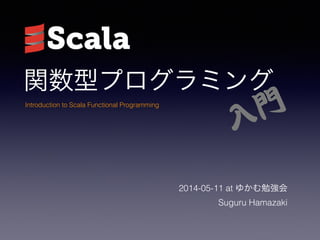








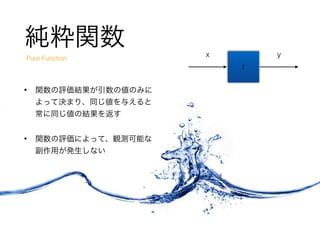

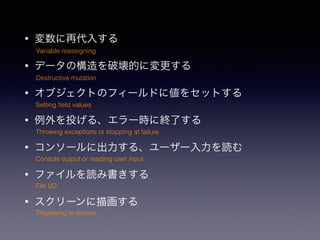



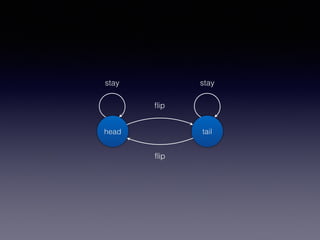
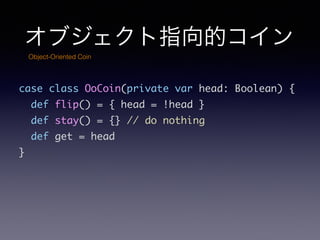
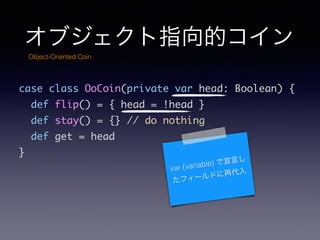
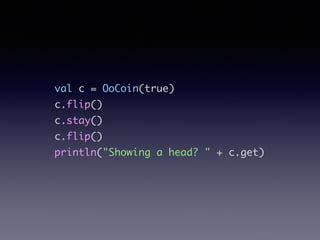


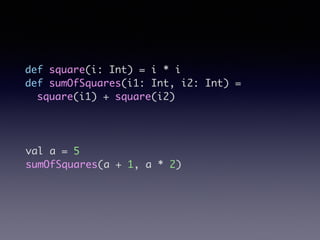
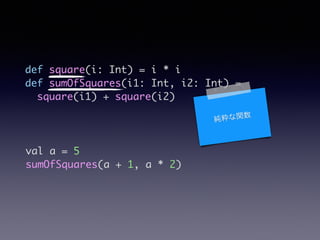
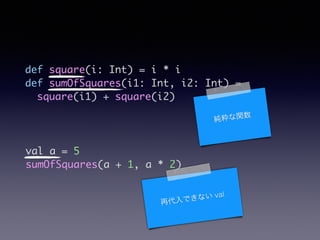
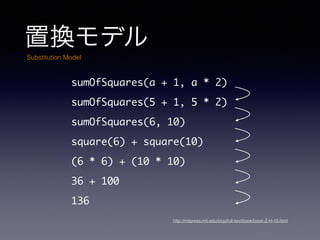


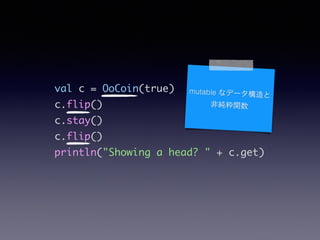
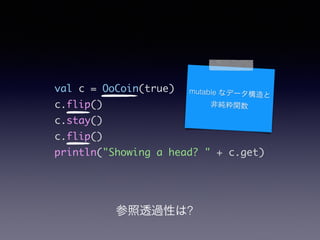

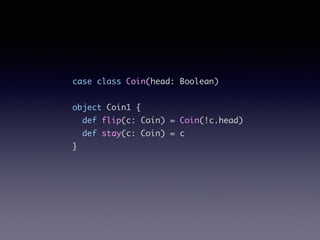
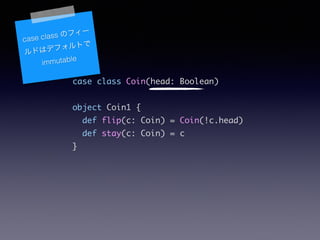
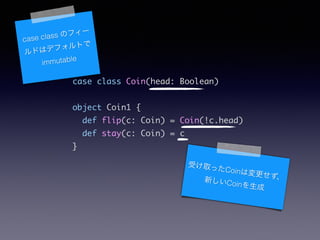
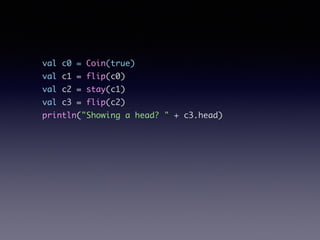
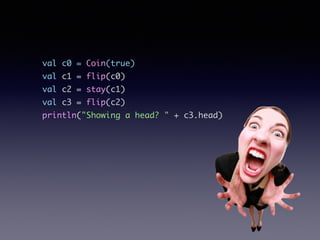

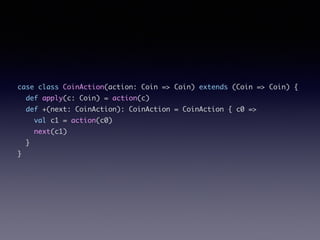
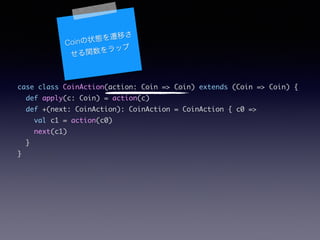
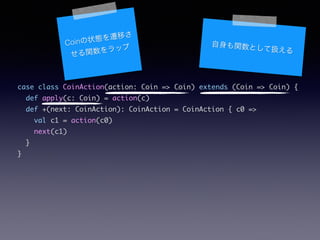
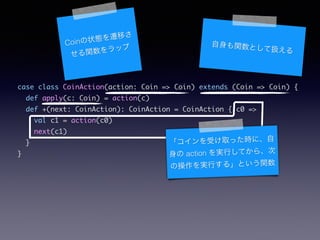


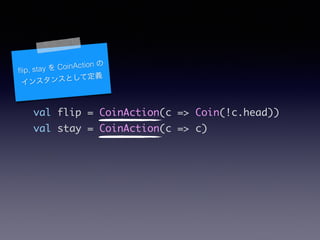
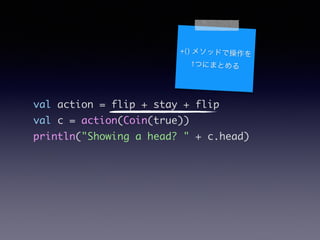

)
extends (Coin => (Coin, A)) {
def apply(c: Coin) = action(c)
def +[B](next: CoinAction[B]): CoinAction[B] =
flatMap(_ => next)
def map[B](f: A => B): CoinAction[B] = CoinAction { c0 =>
val (c1, a) = apply(c0)
(c1, f(a))
}
def flatMap[B](f: A => CoinAction[B]): CoinAction[B] =
CoinAction { c0 =>
val (c1, a) = apply(c0)
f(a)(c1)
}
}](https://image.slidesharecdn.com/fpcalisthenics-140511000031-phpapp01/85/Introduction-to-Scala-Functional-Programming-46-320.jpg)
)
extends (Coin => (Coin, A)) {
def apply(c: Coin) = action(c)
def +[B](next: CoinAction[B]): CoinAction[B] =
flatMap(_ => next)
def map[B](f: A => B): CoinAction[B] = CoinAction { c0 =>
val (c1, a) = apply(c0)
(c1, f(a))
}
def flatMap[B](f: A => CoinAction[B]): CoinAction[B] =
CoinAction { c0 =>
val (c1, a) = apply(c0)
f(a)(c1)
}
}
Coinż╚ę╗Šwż╦╚╬ęŌż╬ą═ż╬ĮY╣¹ż“ĘĄż╣](https://image.slidesharecdn.com/fpcalisthenics-140511000031-phpapp01/85/Introduction-to-Scala-Functional-Programming-47-320.jpg)
)
extends (Coin => (Coin, A)) {
def apply(c: Coin) = action(c)
def +[B](next: CoinAction[B]): CoinAction[B] =
flatMap(_ => next)
def map[B](f: A => B): CoinAction[B] = CoinAction { c0 =>
val (c1, a) = apply(c0)
(c1, f(a))
}
def flatMap[B](f: A => CoinAction[B]): CoinAction[B] =
CoinAction { c0 =>
val (c1, a) = apply(c0)
f(a)(c1)
}
}
Coinż╚ę╗Šwż╦╚╬ęŌż╬ą═ż╬ĮY╣¹ż“ĘĄż╣
▀węŲżĘż┐ĮY╣¹ż“
╚╬ęŌż╬ą═ż╦ēõōQż╣żļ](https://image.slidesharecdn.com/fpcalisthenics-140511000031-phpapp01/85/Introduction-to-Scala-Functional-Programming-48-320.jpg)
)
extends (Coin => (Coin, A)) {
def apply(c: Coin) = action(c)
def +[B](next: CoinAction[B]): CoinAction[B] =
flatMap(_ => next)
def map[B](f: A => B): CoinAction[B] = CoinAction { c0 =>
val (c1, a) = apply(c0)
(c1, f(a))
}
def flatMap[B](f: A => CoinAction[B]): CoinAction[B] =
CoinAction { c0 =>
val (c1, a) = apply(c0)
f(a)(c1)
}
}
Coinż╚ę╗Šwż╦╚╬ęŌż╬ą═ż╬ĮY╣¹ż“ĘĄż╣
▀węŲżĘż┐ĮY╣¹ż“
╚╬ęŌż╬ą═ż╦ēõōQż╣żļ
┤╬ż╬▓┘ū„ż╚ĮMż▀║Žż’ż╗żļĪŻż┐ż└żĘĪó
Ū░ż╬ĮY╣¹ż“į¬ż╦┤╬ż╬▓┘ū„ż“╔·│╔ż╣żļ
ķv╩²ż╚żĘżŲ╩▄ż▒╚Īżļ](https://image.slidesharecdn.com/fpcalisthenics-140511000031-phpapp01/85/Introduction-to-Scala-Functional-Programming-49-320.jpg)
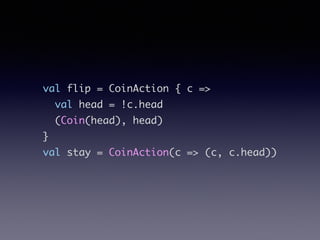
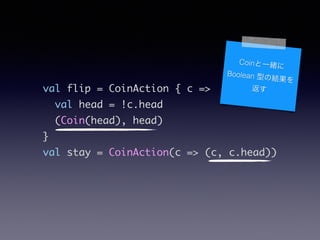
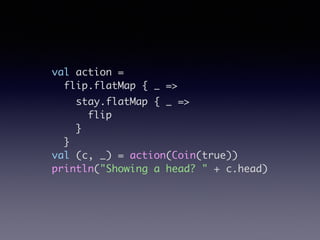
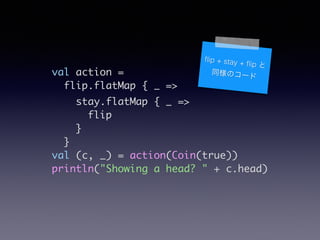
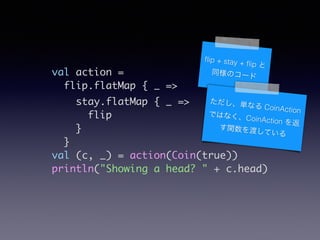
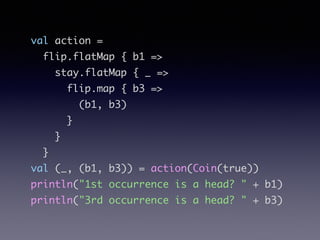




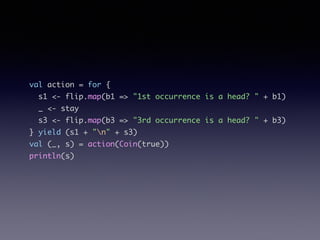
![val action = for {
s1 <- flip.map(b1 => "1st occurrence is a head? " + b1)
_ <- stay
s3 <- flip.map(b3 => "3rd occurrence is a head? " + b3)
} yield (s1 + "n" + s3)
val (_, s) = action(Coin(true))
println(s)
ż│ż╬ĢrĄŃżŪĪó
CoinAction[Boolean] ż“
CoinAction[String] ż╦ēõōQżĘżŲ
żĘż▐ż”](https://image.slidesharecdn.com/fpcalisthenics-140511000031-phpapp01/85/Introduction-to-Scala-Functional-Programming-61-320.jpg)

)
extends (Coin => (Coin, A)) {
def apply(c: Coin) = action(c)
def +[B](next: CoinAction[B]): CoinAction[B] =
flatMap(_ => next)
def map[B](f: A => B): CoinAction[B] = CoinAction { c0 =>
val (c1, a) = apply(c0)
(c1, f(a))
}
def flatMap[B](f: A => CoinAction[B]): CoinAction[B] =
CoinAction { c0 =>
val (c1, a) = apply(c0)
f(a)(c1)
}
}](https://image.slidesharecdn.com/fpcalisthenics-140511000031-phpapp01/85/Introduction-to-Scala-Functional-Programming-63-320.jpg)
)
extends (Coin => (Coin, A)) {
def apply(c: Coin) = action(c)
def +[B](next: CoinAction[B]): CoinAction[B] =
flatMap(_ => next)
def map[B](f: A => B): CoinAction[B] = CoinAction { c0 =>
val (c1, a) = apply(c0)
(c1, f(a))
}
def flatMap[B](f: A => CoinAction[B]): CoinAction[B] =
CoinAction { c0 =>
val (c1, a) = apply(c0)
f(a)(c1)
}
}
Coin ż╬źßźĮź├ź╔ż“ż╔ż│
ż½żķżŌ║¶żė│÷żĘżŲż╩żż](https://image.slidesharecdn.com/fpcalisthenics-140511000031-phpapp01/85/Introduction-to-Scala-Functional-Programming-64-320.jpg)
) {
def map[B](f: A => B): State[S, B] =
State { s =>
val (s2, a) = run(s)
(s2, f(a))
}
def flatMap[B](f: A => State[S, B]): State[S, B] =
State { s =>
val (s2, a) = run(s)
f(a).run(s2)
}
}
Coin ż“ą═źčźķźß®`ź┐®`
S ż╚żĘżŲ│ķŽ¾╗»
Functional Programming in Scala
http://www.manning.com/bjarnason/ żĶżĻÆi╗éĪóę╗▓┐Ė─ēõ](https://image.slidesharecdn.com/fpcalisthenics-140511000031-phpapp01/85/Introduction-to-Scala-Functional-Programming-65-320.jpg)
![type CoinAction[A] = State[Coin, A]
val flip: CoinAction[Boolean] = State { c =>
val head = !c.head
(Coin(head), head)
}
val stay: CoinAction[Boolean] = State(c => (c, c.head))
CoinAction ż“ type alias
ż╚żĘżŲČ©┴x](https://image.slidesharecdn.com/fpcalisthenics-140511000031-phpapp01/85/Introduction-to-Scala-Functional-Programming-66-320.jpg)



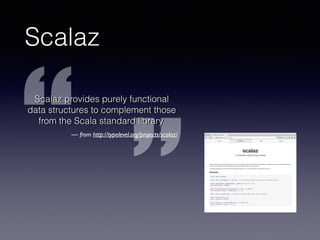
![import scalaz.State
type CoinAction[A] = State[Coin, A]
scalaz ż╬ State ż“╩╣ż”](https://image.slidesharecdn.com/fpcalisthenics-140511000031-phpapp01/85/Introduction-to-Scala-Functional-Programming-71-320.jpg)




